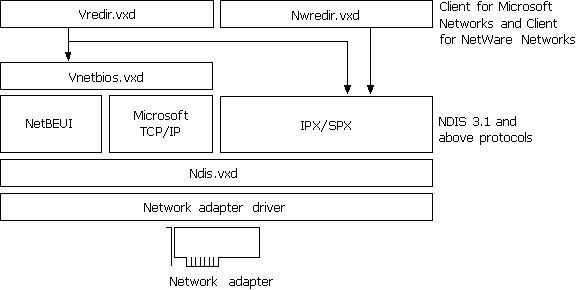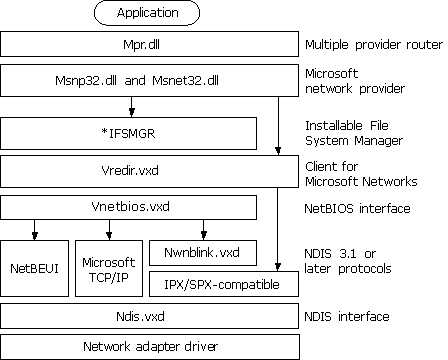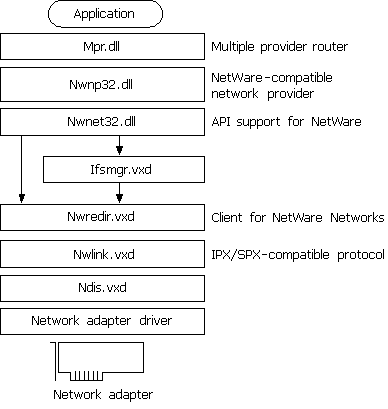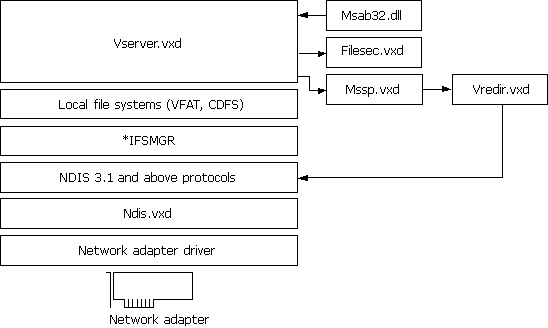
You can install either or both of the 32-bit, protected-mode networking clients, Client for Microsoft Networks and Client for NetWare Networks. The following sections describe the architecture for these two clients and the related peer servers.
Figure 29.15 shows the architecture for both network clients.

Figure 29.15 Architecture for Client for NetWare Networks used with Client for Microsoft Networks
Windows 98 provides a 32-bit, protected-mode file system driver to support all Microsoft networking products that use the SMB file sharing protocol. This includes LAN Manager, Windows NT, Windows for Workgroups 3.x, Workgroup Add-on for MS-DOS, Windows 95, and Windows 98. Also supported are network products from other vendors using the Microsoft network standard, such as IBM LAN Server, IBM OS/2 Warp Server, and Samba servers. Figure 29.16 shows the architecture for Microsoft networking.

Figure 29.16 Windows 98 architecture for Microsoft networking
Client for Microsoft Networks supports connectivity over any NDIS protocol that supports a NetBIOS interface and is accessible through Vnetbios.vxd. The protected-mode protocols provided with Windows 98 that support a NetBIOS interface are the following:
Client for Microsoft Networks also supports connectivity over IPX/SPX using Nwlink.vxd without the NetBIOS interface.
You can use Client for NetWare Networks in an environment where all that is needed is a 32-bit client to connect to existing NetWare servers (for example, if there is no need for SMB-based peer resource sharing services). Figure 29.17 shows the architecture for this configuration.

Figure 29.17 Architecture for Client for NetWare Networks as the sole client
For more details about the architecture for Windows 98 with Novell-supplied network clients, see Chapter 17, "Windows 98 on Third-Party Networks."
Windows 98 includes components to support file and printer sharing on Microsoft networks and NetWare networks.
When File and Printer Sharing for Microsoft Networks is installed, the Windows 98 SMB server (Vserver.vxd) is added to the computerís configuration. This component supports all Microsoft networking products that use the SMB file sharing protocol. Figure 29.18 shows the basic supporting files for File and Printer Sharing for Microsoft Networks in the Windows 98 networking architecture.

Figure 29.18 Architecture for File and Printer Sharing for Microsoft Networks
When File and Printer Sharing for NetWare Networks is installed, the Windows 98 NCP server (Nwserver.vxd) is added to the computerís configuration. Client for NetWare Networks is used to get NetWare server connection information and to enable user-level security based on a NetWare serverís user accounts. Figure 29.19 shows the supporting files for File and Printer Sharing for NetWare Networks in the Windows 98 networking architecture.

Figure 29.19 Architecture for File and Printer Sharing for NetWare Networks
For file and printer sharing services with user-level security, the security provider (Mssp.vxd or Nwsp.vxd) assists in validating user access when sharing a resource and in retrieving a user list when administrating the server. The network address book (Msab32.dll or Nwab32.dll) translates the account lists from the server and provides the Add Users dialog box for selecting which users get access rights. The file security component (Filesec.vxd) provides access control based on information in the registry. Notice that these same security components support features such as remote registry access even when file and printer sharing services are not present.